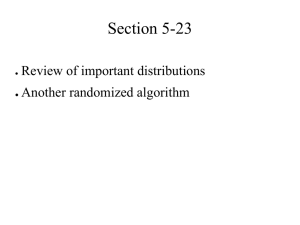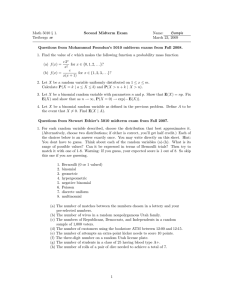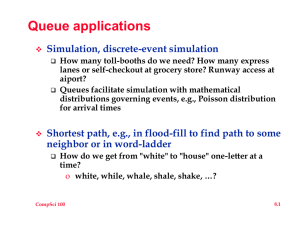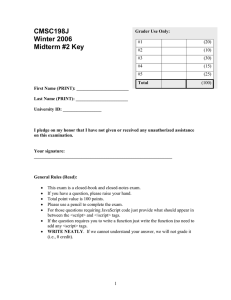Math 5010-1 Name Solutions Midterm Exam 2
advertisement
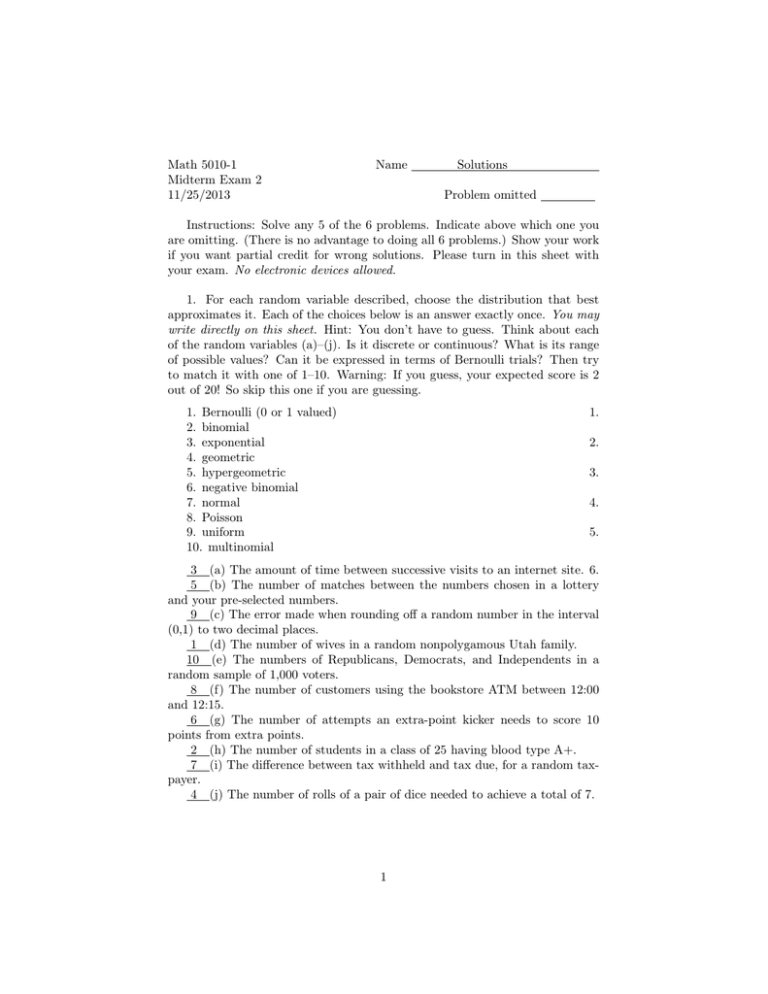
Math 5010-1
Midterm Exam 2
11/25/2013
Name
Solutions
Problem omitted
Instructions: Solve any 5 of the 6 problems. Indicate above which one you
are omitting. (There is no advantage to doing all 6 problems.) Show your work
if you want partial credit for wrong solutions. Please turn in this sheet with
your exam. No electronic devices allowed.
1. For each random variable described, choose the distribution that best
approximates it. Each of the choices below is an answer exactly once. You may
write directly on this sheet. Hint: You don’t have to guess. Think about each
of the random variables (a)–(j). Is it discrete or continuous? What is its range
of possible values? Can it be expressed in terms of Bernoulli trials? Then try
to match it with one of 1–10. Warning: If you guess, your expected score is 2
out of 20! So skip this one if you are guessing.
1. Bernoulli (0 or 1 valued)
2. binomial
3. exponential
4. geometric
5. hypergeometric
6. negative binomial
7. normal
8. Poisson
9. uniform
10. multinomial
1.
2.
3.
4.
5.
3 (a) The amount of time between successive visits to an internet site. 6.
5 (b) The number of matches between the numbers chosen in a lottery
and your pre-selected numbers.
9 (c) The error made when rounding off a random number in the interval
(0,1) to two decimal places.
1 (d) The number of wives in a random nonpolygamous Utah family.
10 (e) The numbers of Republicans, Democrats, and Independents in a
random sample of 1,000 voters.
8 (f) The number of customers using the bookstore ATM between 12:00
and 12:15.
6 (g) The number of attempts an extra-point kicker needs to score 10
points from extra points.
2 (h) The number of students in a class of 25 having blood type A+.
7 (i) The difference between tax withheld and tax due, for a random taxpayer.
4 (j) The number of rolls of a pair of dice needed to achieve a total of 7.
1
2. Sicherman dice are fair six-sided dice, but instead of the numbers 1, 2,
3, 4, 5, 6 appearing on each die, the numbers 1, 2, 2, 3, 3, 4 appear on one die
and the numbers 1, 3, 4, 5, 6, 8 appear on the other. If X is the number that
turns up on the first die, and Y is the number that turns up on the second die,
find numerical values for the following (in other words, don’t leave the problem
unfinished):
(a) E[X + Y ].
1+2+2+3+3+4 1+3+4+5+6+8
+
6
6
15 27
5 9
=
+
= + =7
6
6
2 2
E[X + Y ] = E[X] + E[Y ] =
(b) Var(X + Y ).
2
5
12 + 22 + 22 + 32 + 32 + 42
−
6
2
2
2
2
2
2
2
2
1 +3 +4 +5 +6 +8
9
11 59
35
+
−
=
+
=
.
6
2
12 12
6
Var(X + Y ) = Var(X) + Var(Y ) =
3. If 65 percent of the adult population of Utah is in favor of a certain ballot
proposition, consider the probability that a random sample (with replacement)
of 100 such people will contain between 60 and 70 (inclusive) who are in favor.
(a) First write
P a formula for the exact answer, a sum of binomial probabilities, using the
notation.
P =
70 X
100
(0.65)k (0.35)100−k .
k
k=60
(b) Second, give an approximate answer in terms of the distribution function
Φ of the standard normal. Be sure to use a continuity correction, but it is not
necessary to evaluate your answer numerically because that would require a
table or a calculator.
70.5 − 100(0.65)
P ≈Φ p
100(0.65)(0.35)
59.5 − 100(0.65)
−Φ p
.
100(0.65)(0.35)
4. Let X be a uniform random variable on the interval (1,2) and let Y = 1/X.
(a) Find E[Y ].
Z
E[Y ] =
1
10
1 1
ln 10
dx =
.
x 9
9
2
(b) Find the density function of Y .
For 1/10 < y < 1, fY (y) = fX (1/y)|−1/y 2 | = 1/(9y 2 ). To check that
these answers are consistent, we find the mean of Y from its density: E[Y ] =
R1
R1
yfY (y) dy = 1/10 1/(9y) dy = (ln 1 − ln(1/10))/9 = (ln 10)/9.
1/10
5. An urn contains one red ball, two white balls, and three blue balls. Two
balls are chosen at random without replacement. Let X be the number of red
balls in the sample of two, and let Y be the number of white balls in the sample
of two.
(a) Find the joint mass function of X and Y . (Fill in a table, labeling the
rows by the possible values of X and the columns by the possible values of Y .)
row 0, col 0: 3/15.
row 1, col 0: 3/15.
row 0, col 1: 6/15.
row 1, col 1: 2/15.
row 0, col 2: 1/15.
row 1, col 2: 0.
(b) Find the marginal mass functions of X and Y , indicating which is which.
Marginal of X: Sum the rows: 0 with probability 2/3, 1 with probability
1/3.
Marginal of Y : Sum the columns: 0 with probability 6/15, 1 with probability
8/15, 2 with probability 1/15.
6. Let X and Y have joint density function f (x, y) = 8xy, 0 < x < y < 1.
Note that the region where f > 0 is triangular.
(a) Are X and Y independent? (Half credit for correct answer, half credit
for justification of answer.)
Answer is no because the region where f > 0 is not a rectangle, so it can’t
be true that f (x, y) = fX (x)fY (y).
(b) Find P {X/Y > 1/2}. (Before integrating, draw a picture.)
P (X/Y > 1/2) = P (Y < 2X) = P (X > Y /2) =
R1
R1
4y(y 2 − (y/2)2 ) dy = 0 3y 3 dy = 3/4.
0
3
R1Ry
0
y/2
8xy dx dy =
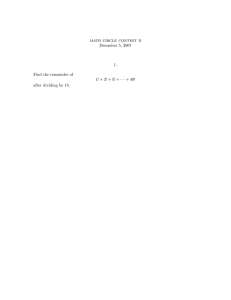
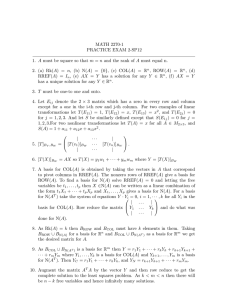

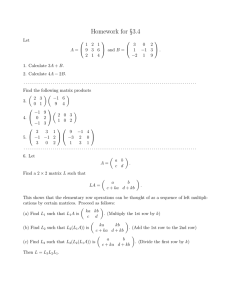
![Quiz #2 & Solutions Math 304 February 12, 2003 1. [10 points] Let](http://s2.studylib.net/store/data/010555391_1-eab6212264cdd44f54c9d1f524071fa5-300x300.png)
